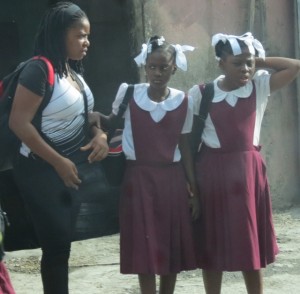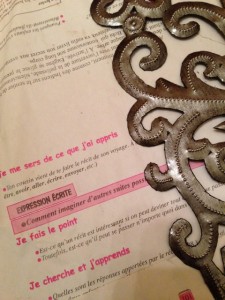Could you read that to me in Kreyol?
Just before Christmas, I received a box from It’s Cactus containing a set of large sculptures I had bought while we were in Haiti in October. Usually when I receive an order, it is pulled from the warehouse shelves in Salinas, CA, packed, and sent on its way. This time, however, I had made my order in Croix-des-Bouquets and it was boxed in Haiti separately from the rest of the It’s Cactus merchandise. When It’s Cactus received the shipment, my box was separated out and sent directly to me without any re-packing. I received it just as it had been packaged up in Haiti.
I am telling you this because of the “surprise” I found inside: My sculptures had been wrapped very thoroughly and carefully in French lessons. Used up pages from French language workbooks; brought home, no doubt, by the artist’s school children who no longer had need of them. Waste not, want not.
It reminded me of something rather astonishing that I had learned on one of our previous trips that has only recently been changed. Up until July 2015, Haitian school children were taught exclusively in French. This, while the language of their country is Kreyol. According to one set of
figures I read, (and you can too) about 1 Haitian in 19 is fluent in French, yet all lessons, from reading to math to science were taught in the French language, oftentimes by teachers who were not among the fluent. Can you even imagine the obstacle this was to a child’s ability to learn? Can you imagine the enormity of the educational handicap when it was applied to an entire nation?
Reading comprehension is based on three things: the representation of letters, the corresponding sounds the letters make, and the meaning of the the collected letters that form words. A child who is unskilled in his own language and taught exclusively in another one may parrot the words that he hears correctly with no real understanding of what he has said. This is compounded in the case of a Haitian child due to the relative closeness of the sound of Kreyol words to French and the large disparity in their meaning. The upshot of all of this is that Haitian Kreyol-speaking children who have been taught only in French have had an incredibly hard time with reading comprehension and corresponding difficulty in reading to learn.
Happily, change is in the air. The new government mandate seeks to promote Haitian Kreyol throughout all levels of education, from kindergarten to university. It entails the standardization of Kreyòl writing, and the training of teachers for instruction of, and in, Kreyòl. Studies clearly demonstrate that children who receive a solid foundation in their native tongue are “set free” to learn not only reading, math and sciences, but second and even third languages as well.
Of course, the larger goal is to elevate the level of education of the population as a whole. Though it will take time, the reward should be greatly worth the government’s investment. With higher levels of skill in reading, math, sciences, and foreign languages, new generations of Haitian students will be able to realize their full potential as productive citizens of an emerging country. As for myself, I hope that maybe my next box from Croix-des-Bouquets will be packed in Kreyol lessons. I would take that as not only a sign of progress but also a sign of the Haitian government’s commitment to the success of the program. Used up Kreyol workbook packing paper – bring it on!
Contributed by Linda for It’s Cactus


